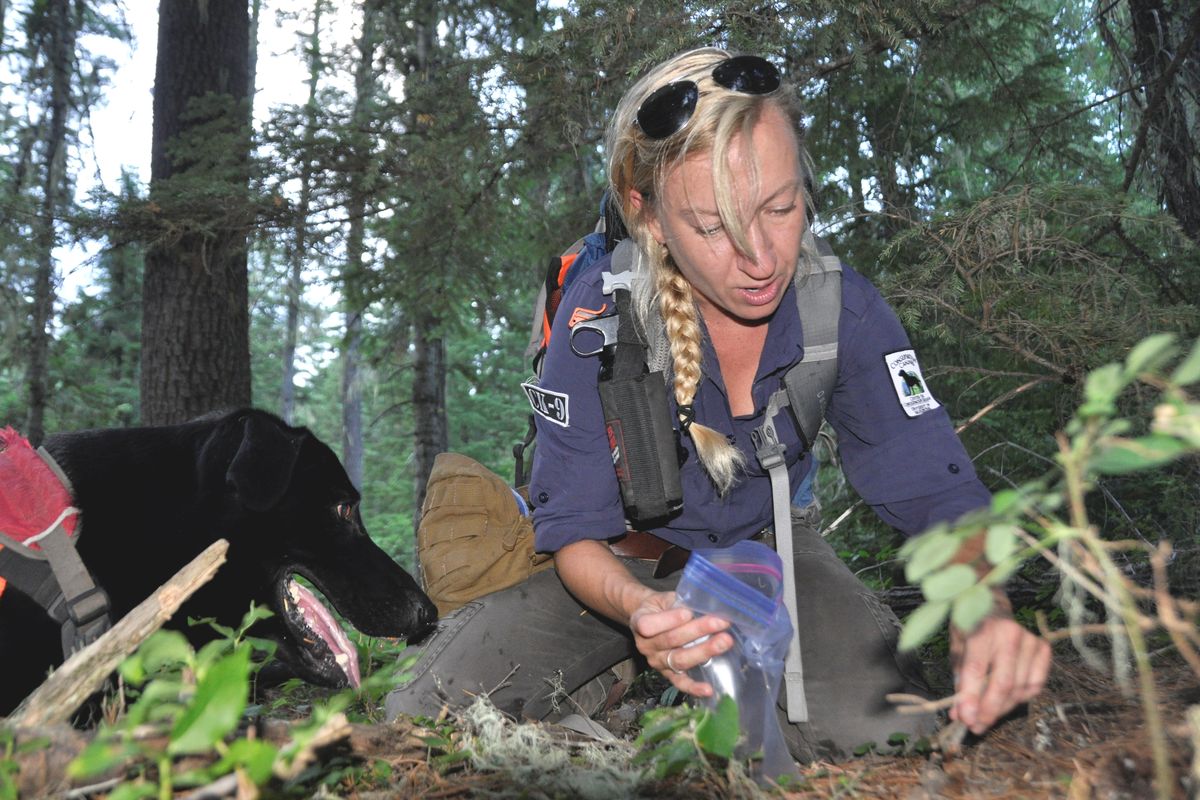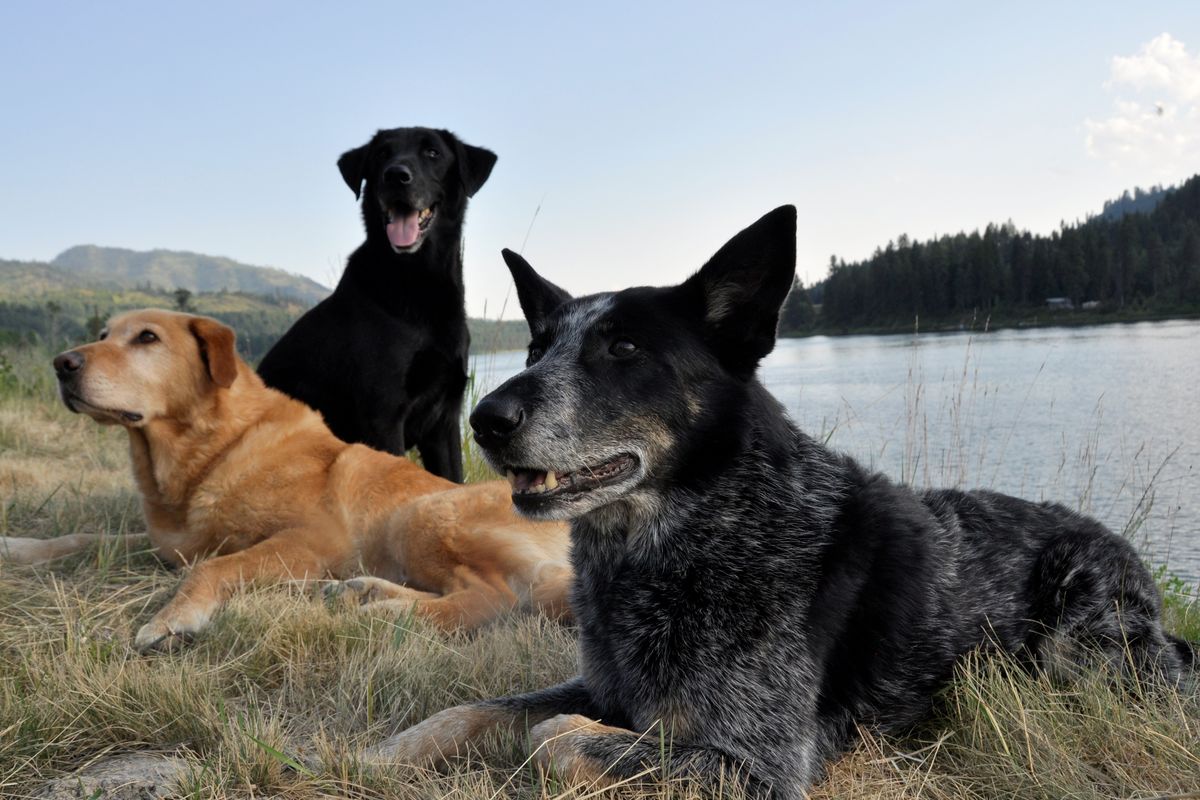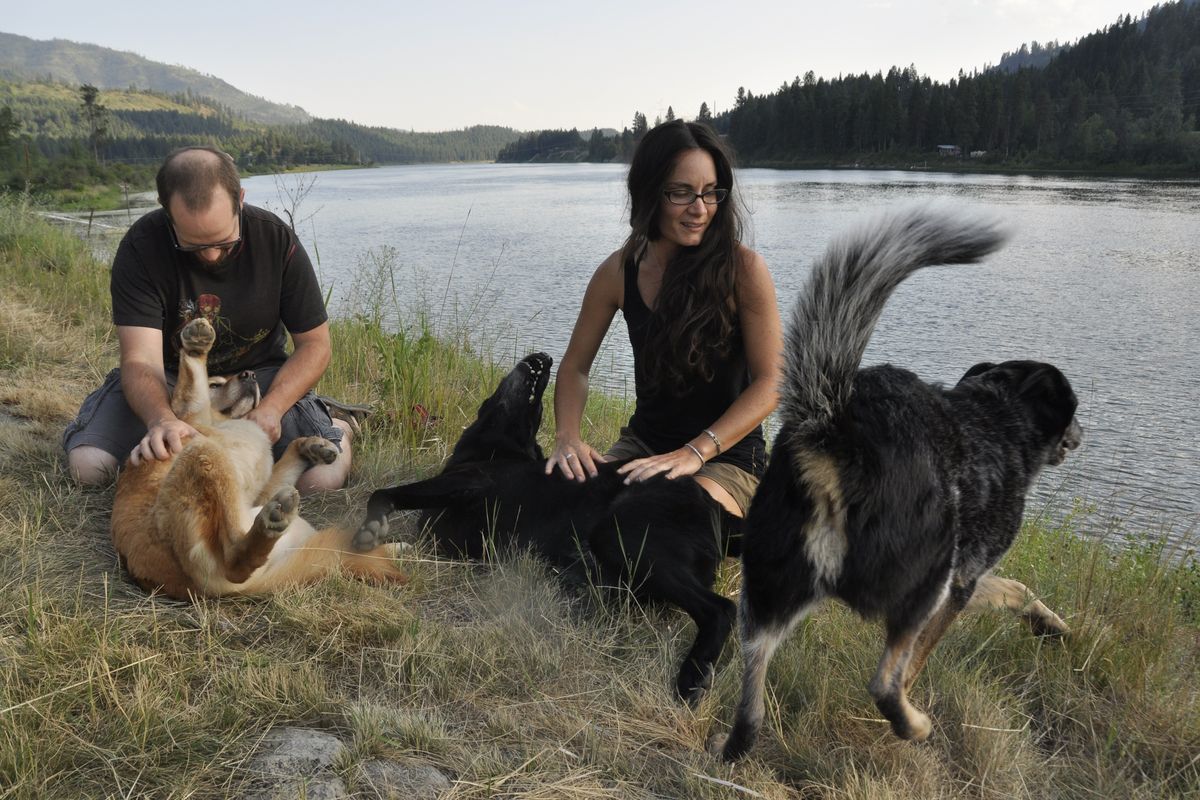Poop-sniffing dogs work for wildlife researchers
Mixed breed dogs chosen from shelters for their keen interest in the reward of playing with a ball are easily trained to find scats of wild creatures in the woods through the Conservation Canines program of the University of Washington Department of Biology. (Rich Landers)
Shelter dogs too intense or feisty to be adopted are helping wildlife scientists by doing what comes naturally – running through the woods and sniffing for the poop of other animals. “But they don’t get to roll in it,” said Jennifer Hartman of Conservation Canines. “We’ve heard those jokes.” The noses of the canine misfits are being put to use in Pend Oreille County in a pilot project seeking more information about the interrelationships of wolves and other carnivores – as well as with their prey.
The dogs are tools for studying endangered species and other wildlife that doesn’t require trapping or tranquilizing the animal.
“These dogs have been contracted to work all over the world,” said Julianne Ubigau, a high school science teacher and eight-year veteran with the program based in the University of Washington’s Department of Biology.
For example, Chester, a golden retriever mix, returned recently from a job of sniffing out bear scat in the French Pyrenees.
Scooby, a black Lab mix, has been to Cambodia, Mozambique, the Alberta oil sands, Montana and most recently Mexico for mane wolf research.
The highest profile Conservation Canines project in the Northwest involves dogs trained to put their nose to the wind in a boat and lead researchers to collect the floating poop of endangered killer whales.
The new project in northeastern Washington seeks to learn how the revival of wolves in the region influences the diets of other carnivores and their prey.
The right dogs can be trained within a couple of weeks to lead handlers to scat from specific animals so samples can be collected and sent to labs for analysis that can unlock secrets about wildlife dynamics.
“We take the dogs that can’t find a home because they are too crazy to be chosen for pets,” Ubigau said. “We don’t want dogs interested in poop. We want dogs that are obsessed with playing ball. These are the easiest dogs to reward and train to do the job.”
One of the selection tests involves walking through a dog shelter holding a tennis ball.
“We look for the dogs that see the ball and quiver,” Hartman said. “Their eyes are focused on the ball. Everything about them indicates they want to play with that ball.”
“Then we take them outside and hide the ball,” Ubigau said. “We watch how long the dog will focus on looking for the ball. We pick a dog that has an insatiable desire to play; it would hunt for the ball to exhaustion. That’s the dog for us.
“We need dogs with a strong drive to hunt but not a strong drive for prey. Our dogs can’t be interested in chasing wildlife. Our goal is to be as noninvasive as possible.”
Scat detection dogs are able to locate samples from multiple species simultaneously across large, remote areas repeatedly over time.
Ubigau says sampling with detection dogs tends to be less biased than traditional wildlife detection methods such as remote cameras, radio-collaring, hair snags and trapping.
The method can acquire more reliable information in a shorter a time.
The five dogs being used in Pend Oreille County from a base near Cusick have been trained to sniff out the feces of any carnivore.
“We can change that with a dog by the way we offer the reward, which is to play with the ball,” Ubigau said.
In a project that focused on fishers, the handlers started by introducing the dogs to previously collected fisher scat.
“The dogs caught on fast,” she said. “Before long, we noticed the dogs were often walking on logs because they quickly learned on their own that’s where they had a higher probability of finding fisher poop.”
This spring, as Ubigau, Hartman and Jason Broderick began the pilot project, they trained the dogs to find scat from coyotes, wolves, bears, bobcats, lynx and cougars as well as deer, elk and moose.
“We want data on predators and prey,” Ubigau said.
In their first 30-day session this spring, the three handlers and their dogs collected 3,000 scat samples.
“There’s a lot of poop out there,” she said, pointing to a freezer full of it.
Now in the second of four month-long sessions, they don’t collect every pile of deer and moose droppings the dogs detect or they’d be competing with the coal trains for hopper cars to haul their load.
“We’ve scaled back what we collect or we’d go broke (on the lab costs),” Hartman said. “We key the dogs more to finding fresh stuff, since the lab can get more data from poop that isn’t totally dried out.”
DNA analysis enables researchers to track individual animals and make population estimates. But much more can be determined from scat, including diseases, hormone levels that would indicate pregnant females and diet.
“The further you analyze, the more money it costs,” Hartman said. “We have to stay in our budget.”
The handlers are systematically working the dogs in a 3,100 square mile study area broken down into 66 cells, each of which measures 4.8 square miles.
The dog and the handler wear GPS units that log their course.
Working with Ranger, the youngest and newest dog on the team, Ubigau drove to the edge of a new cell on Monday, fitted the dog with a reflective vest and guard that protects his chest from punctures when going over logs.
She wore a backpack with plenty of water, specimen bags, bear spray and, of course, the all-important ball.
Within 10 minutes of hiking into the forest, Ranger made his first find and sat to be noticed, his eyes locked on Ubigau until she came.
Hartman had told the story about Scooby, on an assignment in Africa, finding a scat as a group of impalas spooked around the dog.
“They were running and jumping behind Scooby, but he just sat focused on the handler as if to say, ‘Come on; I found your poop, now let’s play ball. I don’t care about these other goofy animals.’”
Ranger was similarly focused until Ubigau approached, asked him to back up, which he did, and tossed him the ball for several enthusiastic catches.
“This is what it’s all about for Ranger,” she said.
The dog lay on his belly and continued to give full attention to Ubigau as she collected what she determined to be a bobcat scat and recorded the coordinates on the GPS. Then they moved on.
“It’s a lot of stomping through the woods,” she said.
“I’ve had people come out with me and say this is the best job in the world, following a dog through the forest. But after awhile, they change their tune when they see how much brush we crawl through, the bugs and weather, and then at the end of a session, when you’re the most tired, the dog will go uphill, always uphill, and find another poop.”
Every dog has its own style. Lab mixes tend to range a little farther ahead than cattle dog mixes, but they all get the job done.
The dogs, rescued from uncertain futures at the shelters, have found a piece of heaven with Conservation Canines.
Chester, for example, is getting gray in the muzzle but still looking toward a good life in retirement.
“This will be his last season,” Ubigau said as she let him out of his cage to exercise near the Pend Oreille River. He immediately came to a visitor, sat on his foot and leaned against his leg looking for a scratch.
“He’ll be one of our ambassador dogs when we meet the public and go to science classes at schools. He’s as good at making friends as he is at finding poop.”









